When my daughter was born, I was ready for the sleepless nights, the mountains of laundry, and the joys of new motherhood. I was not at all prepared, it turned out, for the intense hunger and nutritional demands of recovering from childbirth and breastfeeding my newborn. Eating plenty of wholesome, nutrient-dense food became a crucial element of my postpartum journey.
These recipes, designed to meet the needs of both mother and child, are loaded with foods known as galactagogues — like legumes and grains — which are believed to boost milk production. These meals also provide lots of what the postpartum body (and baby!) needs most: healthy fats.
Ingredients such as extra-virgin olive oil, grassfed butter, and ghee are excellent sources of vitamins as well as omega-3 and other fatty acids. A diet rich in these healthy fats can lead to nutrient-dense breast milk and a happy, growing baby.
My senses of smell and taste were heightened in the weeks after delivery, so flavorful dishes like these were a welcomed treat. Better still, most of them can be made or prepped ahead of time, so even the busiest new parents can eat well with ease.
Bone Broth Ramen Bowls
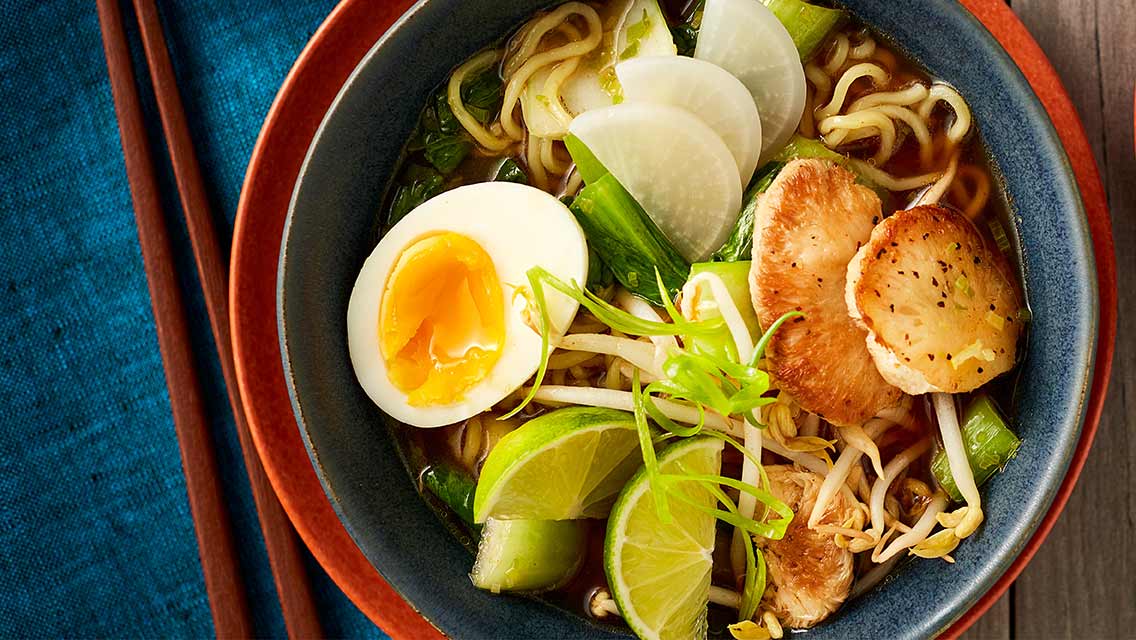
Makes 4 servings • Prep time 30 minutes • Cook time 12 hours
Broth:
- 2 large grassfed beef marrow bones
- 4 large carrots
- 1 yellow onion, cut into wedges
- 1 head garlic, halved lengthwise
- 2 tbs. extra-virgin olive oil
- 2 celery ribs
- 3 bay leaves
- 3 cardamom pods
- ¼ tsp. anise seed
- ¼ tsp. ground cloves
- 1 gallon water
Bowls:
- 1 package ramen noodles (or rice noodles of choice)
- 10 oz. fresh lion’s mane mushrooms (or oyster mushrooms)
- ½ tsp. sea salt
- ¼ tsp. freshly ground black pepper
- 2 tbs. grassfed butter, divided
- 1 green onion, minced
- 1 baby bok choy, cut into 1-in. pieces
- ½ cup mung-bean sprouts
- ¾ cup pickled daikon
- ¼ cup chopped parsley
- 2 soft-boiled eggs
- 1 lime, cut into wedges
- Gochujang to taste
For the broth:
- Preheat oven to 375 degrees F. Place the marrow bones, carrots, onion wedges, and garlic halves on a large sheet pan, and drizzle with the olive oil. Roast for 40 minutes.
- After roasting, place the contents of the pan and the remaining ingredients in a large, heavy-bottomed pot or Dutch oven.
- Let simmer over very low heat for eight to 12 hours.
- Using a fine mesh sieve, drain the broth into a bowl and refrigerate until the fat solidifies on top. Carefully remove the fat and reserve it for another purpose.
For the bowls:
- Place broth in a pot on the stove to reheat. In a separate pot, cook the noodles according to package directions. Cut the mushrooms into ½-inch-thick slices and season with the salt and pepper. In a medium sauté pan, melt 1 tablespoon of the butter over medium heat until it just begins to brown. Cook the mushrooms until deeply golden, approximately two minutes per side. Remove from the pan and set aside.
- Add the rest of the butter, the minced green onion, and the bok choy to the pan. Sauté for five minutes, or until tender and fragrant.
- To assemble, arrange noodles, mushrooms, greens, and sprouts in bowls, and ladle 1 cup (or more) bone broth over each.
- Top with pickled radishes, parsley, a halved soft-boiled egg, lime wedges, and gochujang sauce to taste.
Pregnancy prep: Make a large batch of bone broth, divide into 16-ounce wide-mouth jars, and freeze.
Essential elements:
- Bone broth is a hydrating, nutrient-dense postpartum food that provides collagen, minerals, fatty acids, and vitamins crucial to healthy lactation and postpartum recovery.
- Lion’s mane mushrooms contain beta-glucan, which can help increase prolactin, a hormone that supports milk production. Lion’s mane may also help reduce anxiety and improve sleep.
Amaranth and Oat Breakfast Muffins

Makes 12 muffins • Prep time 10 minutes • Cook time 18-20 minutes
- ½ cup amaranth flour
- 1 cup oat flour
- 1 tsp. baking soda
- 1 tsp. baking powder
- ¼ tsp. ground cinnamon
- ¼ tsp. ground cardamom
- 1 mashed banana
- 1 tsp. vanilla extract
- ½ cup oat milk
- ¼ cup melted butter
- 2 tbs. pure maple syrup
- 1 egg
- ¼ cup chocolate chips (optional)
- Preheat oven to 350 degrees F and grease a 12-cup muffin tin. Mix the dry ingredients together in a medium bowl. In a separate, larger bowl, mix the banana, vanilla, oat milk, melted butter, maple syrup, and egg. Add the dry ingredients and mix until just combined. Fold in the chocolate chips, if desired.
- Spoon the batter into the prepared muffin tin. Bake for 18 to 20 minutes, or until a toothpick inserted in the center of a muffin comes out clean. Serve warm with your favorite nut butter.
Pregnancy prep: These muffins will keep for months in the freezer. Double the batch and thaw them in the toaster oven one (or two!) at a time.
Essential elements:
- Amaranth may help stimulate milk production and reduce postpartum hair loss.
- Oats are a galactagogue food loaded with calcium, iron, and other minerals.
- Bananas contain magnesium, which may help relieve postpartum depression, and vitamin B6, which supports energy production in the body.
Crispy-Skin Salmon With Brown-Butter Quinoa

Makes 2 servings • Prep time 5 minutes • Cook time 20 minutes
For the quinoa:
- Cut the butter into several pieces and melt in a medium saucepan over medium heat, stirring frequently, until it browns and begins to smell nutty. Add the minced whites of the onion and the dry quinoa. Sauté for approximately two minutes to toast the quinoa.
- Add the salt and the vegetable broth and bring to a simmer. Turn the heat to low, cover the pan, and cook for 10 to 15 minutes, or until the liquid is absorbed and the quinoa is tender.
- Fluff the quinoa with a fork, top with minced onion greens, and serve with the salmon.
For the salmon:
- In a small bowl, whisk together the miso, honey, and olive oil.
- Pat the salmon dry and season the flesh with sea salt.
- Lay the salmon skin-side down in a cold cast-iron skillet. Turn heat to medium and cook the fillets, undisturbed, for seven to 10 minutes, until they are almost cooked through and the skin is crispy — you’ll know it’s ready when it releases easily from the pan.
- Brush with the miso-honey sauce, flip with a fish spatula, and remove from heat.
- Leave the fish in the hot pan for one to three minutes more, until the fish flakes easily, then remove it from the pan and serve with the quinoa.
Pregnancy prep: Make the quinoa ahead of time and store in the freezer for up to six months.
Essential elements:
- Salmon is a great source of DHA, a type of fat that benefits a baby’s nervous system, and EPA, an omega-3 fatty acid that may help relieve postpartum depression.
- Quinoa is high in protein and iron, which can help replenish blood levels after delivery.
- Miso, though salty, is rich in vitamins and minerals, including copper, magnesium, zinc, and vitamin K. The fermentation process that produces miso may help boost digestion and bolster the immune system.
Slow-Braised Beef Breakfast Burritos

Makes 10 servings • Prep time 20 minutes • Cook time 4 hours
- 1 tbs. ground cumin
- 1 tbs. smoked paprika
- 1 tbs. dried oregano
- 1 tsp. ground coriander
- ½ tsp. ground allspice
- ¼ tsp. ground anise seed
- Chili powder to taste
- 3 lb. grassfed beef chuck roast
- 2 tbs. extra-virgin olive oil, divided
- ½ yellow onion, chopped
- 2 garlic cloves, minced
- 1 ½ cups beef stock or bone broth
- 1 bay leaf
- 1 dozen organic eggs
- 1 bell pepper, minced
- 1 cup minced fresh cilantro
- ½ cup shredded pepper jack cheese
- 10 large flour or grain-free tortillas
- Mix the cumin, paprika, oregano, coriander, allspice, anise, and chili powder in a bowl. Use 2 tablespoons of the mix to coat the chuck roast.
- Heat 1 tablespoon of the olive oil in a Dutch oven until shimmering. Quickly sear the roast on all sides, then remove and set aside. Add the onion to the Dutch oven and cook until fragrant. Add the garlic and sauté for another 30 seconds, then deglaze with the stock or broth.
- Return the chuck roast to the Dutch oven, add the bay leaf, stir in the remainder of the spice blend, and cover. Reduce heat to low and simmer for three to four hours, or until the meat begins to fall apart. Shred using two forks.
- In a cast-iron skillet, heat the remaining 1 tablespoon of olive oil over medium heat. Scramble the eggs with the bell peppers and cilantro.
- Pile meat, eggs, and a pinch of cheese on a warmed tortilla. Fold in the left and right sides, then roll tightly to form a burrito.
- Repeat with the remaining tortillas.
Pregnancy prep: Make these burritos ahead of time and allow the ingredients to cool completely. Wrap the burritos individually in aluminum foil, and freeze.
Essential elements:
- Beef is a rich source of iron and zinc — and beef from grassfed cattle contains more omega-3 fats than beef from grainfed cattle.
- Eggs are one of the best food sources of choline, a micronutrient essential for brain development. Organic eggs contain higher levels of nutrients overall, especially of omega-3 fats.
Rosemary Roasted-Vegetable Hummus With Semolina Fry Bread
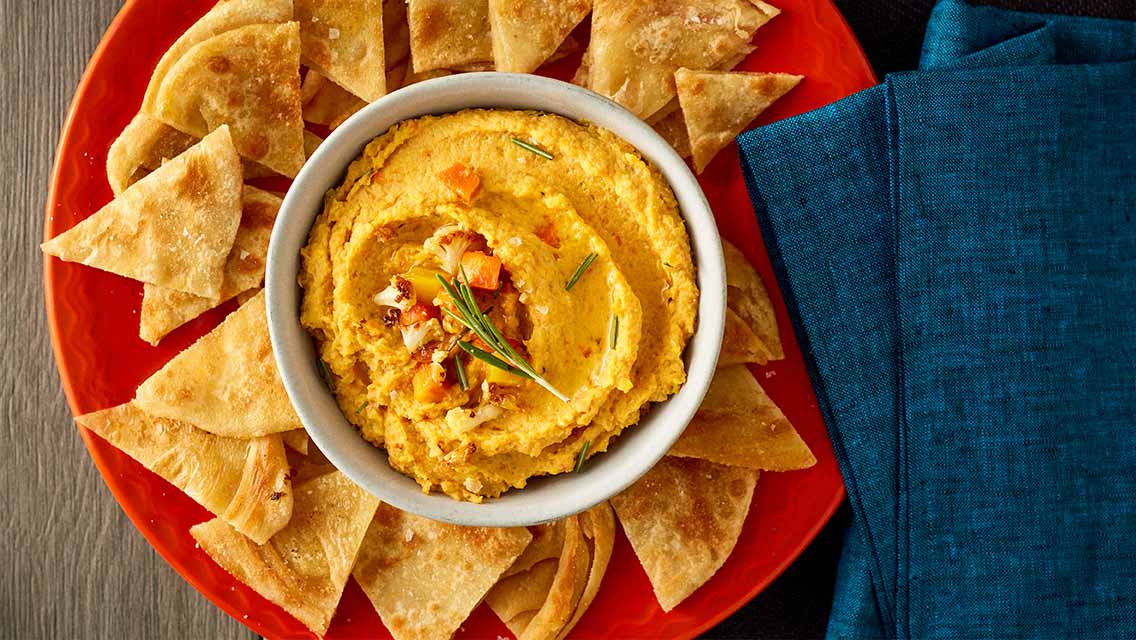
Makes 12 servings • Prep time 20 minutes • Cook time 40 minutes
Hummus:
- 2 sprigs rosemary
- 1 large sweet potato, peeled and chopped
- 1 large carrot, peeled and chopped
- 2 parsnips, peeled and chopped
- 1 large golden beet, peeled and chopped
- 1 medium head cauliflower, cut into florets
- 6 cloves garlic, smashed and peeled
- 3 tbs. extra-virgin olive oil
- ½ tsp. sea salt
- 2 15-oz. cans chickpeas, drained and rinsed
- Juice of ½ lemon
- ½ cup tahini
- ¼ cup low-sodium vegetable broth
- 3 ½ tbs. grassfed ghee, divided
Fry bread:
- ¼ tsp. active yeast
- 1 tbs. sea salt
- 1 tbs. cane sugar
- 3 cups all-purpose flour
- 1 cup plus 3 tbs. semolina flour
- 1 ½ cups warm water
- 1 cup extra-virgin olive oil, divided
- ¼ cup grassfed butter or ghee, melted
For the hummus:
- Preheat oven to 375 degrees F.
- Remove rosemary leaves from the stem and toss the leaves into a baking dish with the vegetables, garlic, olive oil, and salt. Roast until tender, about 35 minutes.
- Using a large food processor or a bowl and immersion blender, purée the vegetables.
- Add the chickpeas, lemon juice, tahini, vegetable broth, and 3 tablespoons of the ghee, and blend until thick and smooth.
- Drizzle the remaining ½ tablespoon of ghee on top, and serve with pita or crackers, or try our fry bread recipe.
For the fry bread:
- In a large bowl or the bowl of a stand mixer, combine the yeast, salt, sugar, all-purpose flour, and 1 cup of the semolina flour. Add the water and mix until a shaggy dough forms.
- Knead by hand for 10 minutes or in a mixer with a dough hook attachment for five minutes, until the dough forms a smooth ball.
- Use a teaspoon or two of the olive oil to coat a baking sheet.
- Divide the dough into 12 equal balls, place them on the baking sheet, and cover them with a tea towel. Let rest for 10 minutes.
- Pour 3 tablespoons of the olive oil into a shallow bowl and use another tablespoon to oil a cutting board or countertop.
- Working with one at a time, dip a dough ball into the bowl of olive oil, then use your hands to stretch it into an oval shape as thin as possible without tearing and lay it on the prepared cutting board or countertop.
- Brush the dough with melted butter or ghee and sprinkle with a pinch of the remaining semolina.
- Fold the left side into the center, then fold the right side to the far left edge to form a long rectangle (similar to the way you would fold a letter in thirds). Brush again with butter or ghee and sprinkle with another pinch of semolina. Fold the top into the center, then fold the bottom to the top edge to form a small square (watch the video just below on how to fold your fry bread!). Repeat with the rest of the dough.
- Heat the remaining olive oil over medium-high heat in a cast-iron or nonstick skillet.
- Stretch each piece of folded dough between your fingers until it’s roughly five inches on each side. Fry, turning and flipping frequently, until the outside is golden and crispy.
How to Fold Your Fry Bread:
Pregnancy prep:
The hummus and fry bread will both keep in the freezer for several months. Make them ahead of time and store in lunch or snack-size portions. Thaw hummus overnight in the refrigerator, and crisp the fry bread in the oven or a toaster.
Essential elements:
- Rosemary has anti-inflammatory properties and may help soothe anxiety.
- Chickpeas are a great plant-based source of iron, fiber, and crucial vitamins.
- Semolina is rich in protein, iron, and folate, which is crucial for brain development and can help support healthy cell growth.
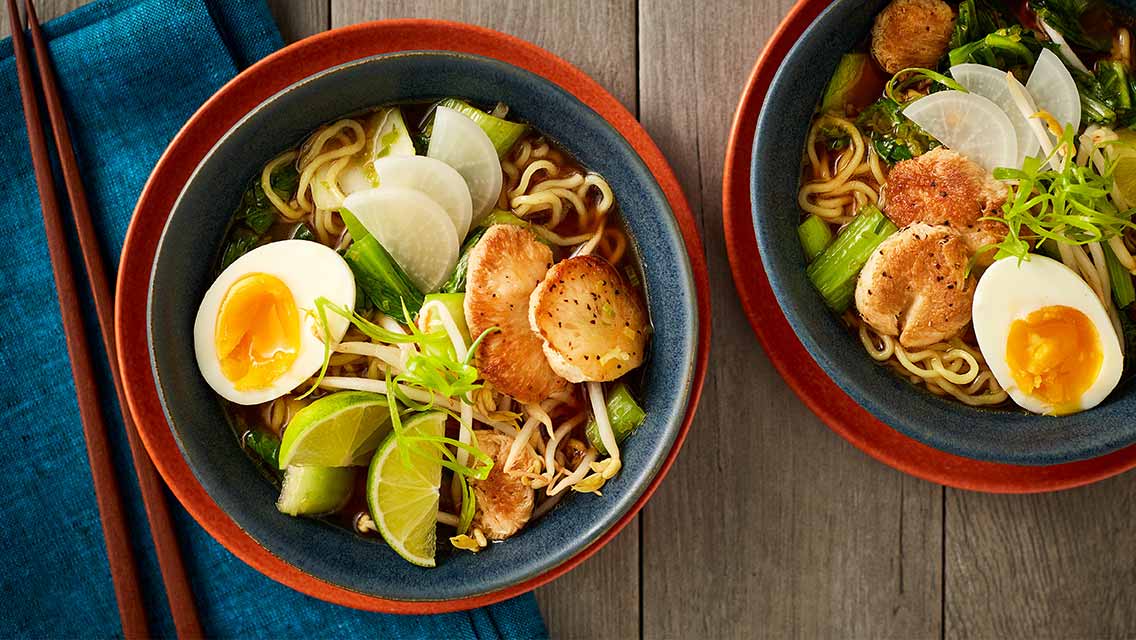


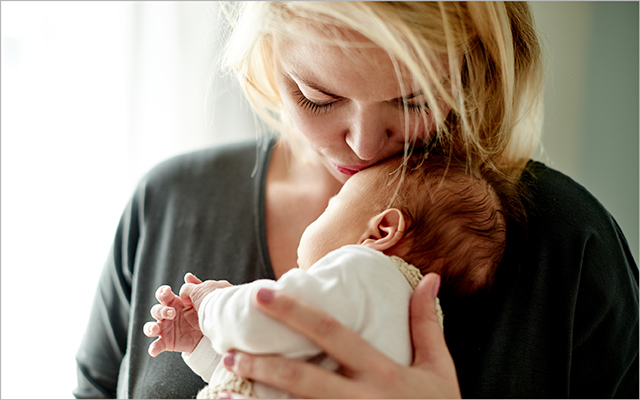
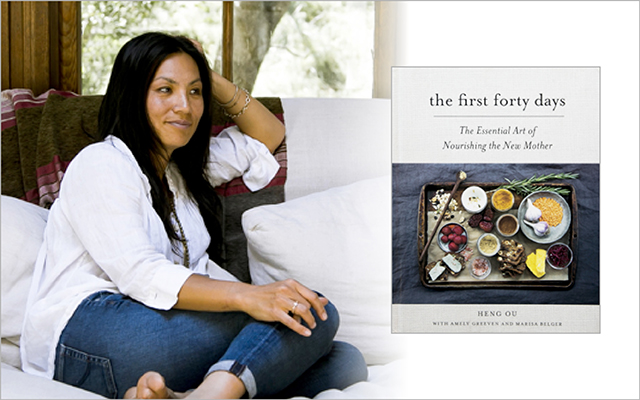

This Post Has 0 Comments